+ Open data
Open data
- Basic information
Basic information
| Entry | Database: PDB / ID: 4yhl | ||||||
|---|---|---|---|---|---|---|---|
| Title | Reversal Agent for Dabigatran | ||||||
 Components Components |
| ||||||
 Keywords Keywords |  IMMUNE SYSTEM / IMMUNE SYSTEM /  Antibody / Antibody /  Dabigatran / Dabigatran /  Pradaxa / Pradaxa /  Antidote / Antidote /  Reversal Agent Reversal Agent | ||||||
| Function / homology |  Immunoglobulins / Immunoglobulins /  Immunoglobulin-like / Immunoglobulin-like /  Sandwich / Mainly Beta Sandwich / Mainly Beta Function and homology information Function and homology information | ||||||
| Biological species |   Homo sapiens (human) Homo sapiens (human) | ||||||
| Method |  X-RAY DIFFRACTION / X-RAY DIFFRACTION /  SYNCHROTRON / SYNCHROTRON /  MOLECULAR REPLACEMENT / Resolution: 2.09 Å MOLECULAR REPLACEMENT / Resolution: 2.09 Å | ||||||
 Authors Authors | Schiele, F. / Nar, H. | ||||||
 Citation Citation |  Journal: Mabs / Year: 2015 Journal: Mabs / Year: 2015Title: Structure-guided residence time optimization of a dabigatran reversal agent. Authors: Schiele, F. / van Ryn, J. / Litzenburger, T. / Ritter, M. / Seeliger, D. / Nar, H. | ||||||
| History |
|
- Structure visualization
Structure visualization
| Structure viewer | Molecule:  Molmil Molmil Jmol/JSmol Jmol/JSmol |
|---|
- Downloads & links
Downloads & links
- Download
Download
| PDBx/mmCIF format |  4yhl.cif.gz 4yhl.cif.gz | 104.2 KB | Display |  PDBx/mmCIF format PDBx/mmCIF format |
|---|---|---|---|---|
| PDB format |  pdb4yhl.ent.gz pdb4yhl.ent.gz | 78.3 KB | Display |  PDB format PDB format |
| PDBx/mmJSON format |  4yhl.json.gz 4yhl.json.gz | Tree view |  PDBx/mmJSON format PDBx/mmJSON format | |
| Others |  Other downloads Other downloads |
-Validation report
| Arichive directory |  https://data.pdbj.org/pub/pdb/validation_reports/yh/4yhl https://data.pdbj.org/pub/pdb/validation_reports/yh/4yhl ftp://data.pdbj.org/pub/pdb/validation_reports/yh/4yhl ftp://data.pdbj.org/pub/pdb/validation_reports/yh/4yhl | HTTPS FTP |
|---|
-Related structure data
| Related structure data | 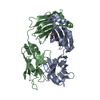 4ygvC 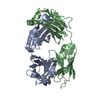 4yhiC 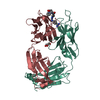 4yhkC 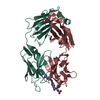 4yhmC 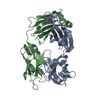 4yhnC 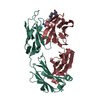 4yhoC 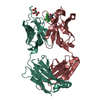 1c1eS S: Starting model for refinement C: citing same article ( |
|---|---|
| Similar structure data |
- Links
Links
- Assembly
Assembly
| Deposited unit | 
| ||||||||
|---|---|---|---|---|---|---|---|---|---|
| 1 |
| ||||||||
| Unit cell |
|
- Components
Components
| #1: Antibody | Mass: 23744.479 Da / Num. of mol.: 1 Source method: isolated from a genetically manipulated source Source: (gene. exp.)   Homo sapiens (human) / Production host: Homo sapiens (human) / Production host:   Cricetinae (hamsters) Cricetinae (hamsters) |
|---|---|
| #2: Antibody | Mass: 23987.822 Da / Num. of mol.: 1 Source method: isolated from a genetically manipulated source Source: (gene. exp.)   Homo sapiens (human) / Production host: Homo sapiens (human) / Production host:   Cricetinae (hamsters) Cricetinae (hamsters) |
| #3: Water | ChemComp-HOH /  Water Water |
-Experimental details
-Experiment
| Experiment | Method:  X-RAY DIFFRACTION X-RAY DIFFRACTION |
|---|
- Sample preparation
Sample preparation
| Crystal | Density Matthews: 2.76 Å3/Da / Density % sol: 55.45 % |
|---|---|
Crystal grow | Temperature: 293 K / Method: vapor diffusion, sitting drop / Details: 100 mM PCB buffer (pH 6) and 25% PEG 1500 |
-Data collection
| Diffraction | Mean temperature: 100 K |
|---|---|
| Diffraction source | Source:  SYNCHROTRON / Site: SYNCHROTRON / Site:  SLS SLS  / Beamline: X06SA / Wavelength: 0.91 Å / Beamline: X06SA / Wavelength: 0.91 Å |
| Detector | Type: PSI PILATUS 6M / Detector: PIXEL / Date: Feb 10, 2012 |
| Radiation | Protocol: SINGLE WAVELENGTH / Monochromatic (M) / Laue (L): M / Scattering type: x-ray |
| Radiation wavelength | Wavelength : 0.91 Å / Relative weight: 1 : 0.91 Å / Relative weight: 1 |
| Reflection | Resolution: 2.09→51.85 Å / Num. obs: 30655 / % possible obs: 100 % / Redundancy: 10.1 % / Biso Wilson estimate: 39.53 Å2 / Rmerge(I) obs: 0.11 / Net I/σ(I): 15.8 |
| Reflection shell | Resolution: 2.09→2.16 Å / Redundancy: 10.4 % / Rmerge(I) obs: 0.63 / Mean I/σ(I) obs: 3.4 / % possible all: 100 |
- Processing
Processing
| Software |
| ||||||||||||||||||||||||||||||||||||||||||||||||||||||||||||||||||||||||||||||||||||||||||||||||||||||||||||||||||
|---|---|---|---|---|---|---|---|---|---|---|---|---|---|---|---|---|---|---|---|---|---|---|---|---|---|---|---|---|---|---|---|---|---|---|---|---|---|---|---|---|---|---|---|---|---|---|---|---|---|---|---|---|---|---|---|---|---|---|---|---|---|---|---|---|---|---|---|---|---|---|---|---|---|---|---|---|---|---|---|---|---|---|---|---|---|---|---|---|---|---|---|---|---|---|---|---|---|---|---|---|---|---|---|---|---|---|---|---|---|---|---|---|---|---|---|
| Refinement | Method to determine structure : :  MOLECULAR REPLACEMENT MOLECULAR REPLACEMENTStarting model: 1C1E Resolution: 2.09→18.43 Å / Cor.coef. Fo:Fc: 0.9488 / Cor.coef. Fo:Fc free: 0.932 / SU R Cruickshank DPI: 0.181 / Cross valid method: THROUGHOUT / σ(F): 0 / SU R Blow DPI: 0.187 / SU Rfree Blow DPI: 0.161 / SU Rfree Cruickshank DPI: 0.16
| ||||||||||||||||||||||||||||||||||||||||||||||||||||||||||||||||||||||||||||||||||||||||||||||||||||||||||||||||||
| Displacement parameters | Biso mean: 40.48 Å2
| ||||||||||||||||||||||||||||||||||||||||||||||||||||||||||||||||||||||||||||||||||||||||||||||||||||||||||||||||||
| Refine analyze | Luzzati coordinate error obs: 0.232 Å | ||||||||||||||||||||||||||||||||||||||||||||||||||||||||||||||||||||||||||||||||||||||||||||||||||||||||||||||||||
| Refinement step | Cycle: 1 / Resolution: 2.09→18.43 Å
| ||||||||||||||||||||||||||||||||||||||||||||||||||||||||||||||||||||||||||||||||||||||||||||||||||||||||||||||||||
| Refine LS restraints |
| ||||||||||||||||||||||||||||||||||||||||||||||||||||||||||||||||||||||||||||||||||||||||||||||||||||||||||||||||||
| LS refinement shell | Resolution: 2.09→2.16 Å / Total num. of bins used: 15
|
 Movie
Movie Controller
Controller



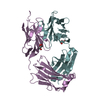
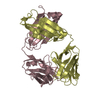
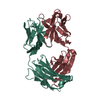
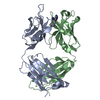

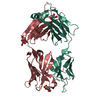
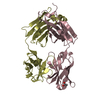
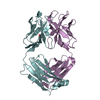
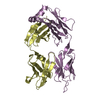

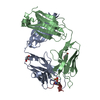
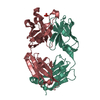


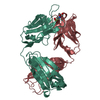
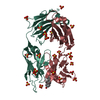
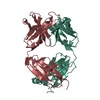
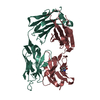
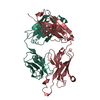
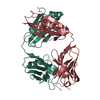
 PDBj
PDBj


